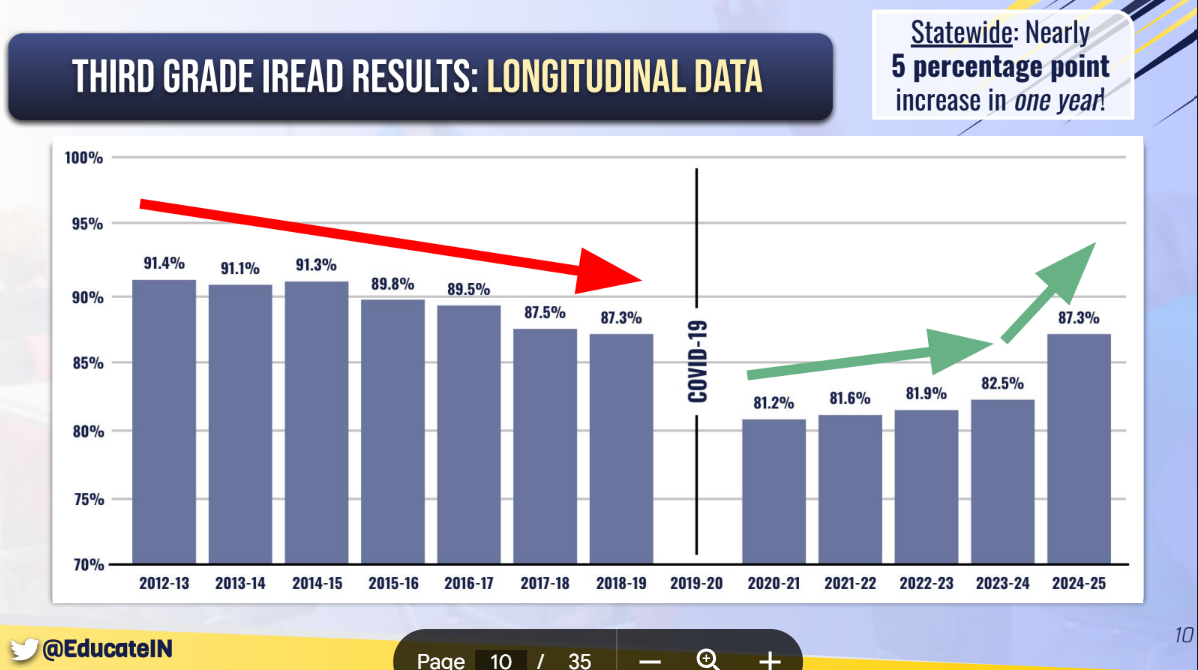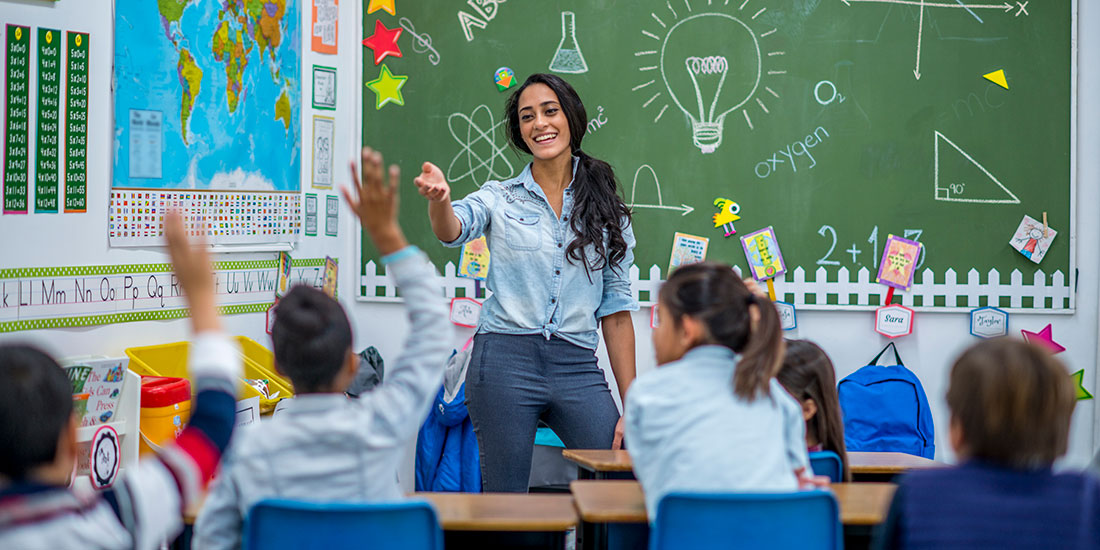Record jump in IREAD scores for 2025; retention law still looms
State education officials celebrate as Indiana’s third grade literacy rates reach a new high, with results from the 2024-2025 IREAD-3 assessment showing a nearly five percentage point increase over the previous year – marking the fourth consecutive year of improvement and the largest single-year gain in state history.
The Indiana Department of Education reports 87.3% of third graders (73,500 students) demonstrated proficient reading skills on the IREAD exam this school year. You likely recall the previous record for year-over-year improvement was set in 2024 (nearly a 1.0% increase), but this year’s jump surpassed it greatly.
“Literally scream this from the rooftops,” State Board of Education member B.J. Watts enthused at Wednesday’s board meeting. “Take a minute to celebrate this . . . I’ve been on this board a long time. I’ve never seen numbers like this.”

Like the rest of the board, Secretary of Education Katie Jenner touts this jump as a win, proving a positive return on roughly $170 million in state and philanthropic investments in early literacy since 2022, when IDOE began sounding alarms over the state’s literacy crisis.
Still, the reality is that 73,500 students out of 84,163 total who took the test passed, meaning roughly 10,000 students did not show reading proficiency. With Indiana’s law requiring the retention of students who do not pass the IREAD by the end of third grade in effect this school year, it’s anticipated that potentially several thousand third graders did not move forward to fourth grade this school year. But, we won’t know the exact number retained until count day October 1.
As frequent readers of this newsletter know, the state’s literacy rates had been in decline from 2013 to 2021, with the pandemic further exacerbating the crisis. In response, Indiana launched a series of strategic investments in early literacy, including the Indiana Literacy Cadre and expanded assessments for second graders. These efforts are now paying off, with literacy rates returning to pre-pandemic levels. Secretary Jenner calls the growth “historic” and credits those above multiyear initiatives.
“The reason why we jumped five percent in one year . . . we’ve never seen any academic jump quite like this, is because of all of the people who put their hand in and said, ‘We can do more.’ ” Dr. Jenner recounts. She challenges, though, “We can do better for kids, and we’re going to keep our foot on the gas pedal. We’re going to continue to improve in Indiana.”
For the first time, every student group saw gains. Black students, Hispanic students, and those in special education each improved by 7.5 points, while English learners gained 7.2 points. Students from low-income households were up by 6.6 points.
This school year marked the first time all second graders across the state took the IREAD in second grade. Starting in 2022, schools could opt in to begin giving the assessment the, but state law in 2024 began requiring it for all schools. This tactic is one of the top that IDOE attributes to the jump in proficiency rates this year. Third graders in 2024-25 had taken the IREAD for the first time starting in spring 2024.
Of this second grade cohort, 81,792 second graders took the IREAD, and 48% passed, while 20% were identified as “on-track” to pass in third grade, and 32% were deemed “at risk.” If a student passed the IREAD in second grade, they do not have to take the test again in third grade, so for those second graders who passed in 2024, their scores are part of this 2025 data.
More than 96% of second graders who were on track last year passed in 2025. This early indicator has proven effective, IDOE officials say, as more than 65% of students who were identified as at-risk in 2024 successfully passed the assessment in 2025.
Starting in second grade, at-risk students have five opportunities to retake the IREAD before the end of third grade, with additional interventions along the way, including state-required summer school classes, both after second and third grade, depending on when a student can pass the exam. Students first take the IREAD in the spring of second grade, and then there are two more opportunities in that summer between second and third grade for students to retake the test. The same timeline then happens in third grade, where students test in the spring, and have two more changes to retake, if needed, in the summer.
Schools in the Indiana Literacy Cadre again this year enjoyed exponential improvements in scores, with IREAD scores for cadre schools jumping by seven percentage points, while non-cadre schools saw an average jump by 3.6 percentage points. The cadre trains teachers in the “science of reading” and embeds literacy coaches in schools. Schools whose scores sit at 70% or lower must also participate in the cadre, per state law.
For the first time, every student group saw gains. Black students posted one of the largest jumps, improving by 7.5 percentage points from last year and recording a total gain of 14.1 points since 2021. Hispanic students also rebounded sharply, climbing 7.5 points after seeing a drop in 2024. Students in special education matched that 7.5-point year-over-year increase, bringing their total improvement over the past four years to 12.2 points.
English learners, whose performance had been stagnant for three years, saw a 7.2-point gain. “This going back up, I think, is especially promising … the plateau is no longer. We’re moving up,” Dr. Jenner highlights.
Low-income students receiving free or reduced-price meals improved by 6.6 points from last year, adding to a 10-point rise since 2021.
Wednesday’s release of scores prompted celebrations during and after the State Board’s morning meeting, with praise from Dr. Jenner, who led rounds of applause for various educators in the room at the meeting, and afterwards, accolades rolled in from Governor Mike Braun (R) and legislative leaders.
“The number of Indiana students learning to read is growing at an unprecedented pace and is yet another example of how we are leading the nation in education,” the Governor boasts. He adds, however, “We will continue to raise the bar and set the model for what is possible when we prioritize educational outcomes and get back to the basics, focusing on the foundations that unlock a lifetime of learning and success.”
House Committee on Education Chair Bob Behning (R) of Indianapolis, oftentimes the crafter of the state’s education policies, agrees that “This historic increase in our third grade literacy rates is tremendous news. It shows Hoosier students are finally getting back on track academically following the disruptions caused by the pandemic, and that the efforts of teachers, students, families and the state to improve reading skills in our children are paying off.”
Rep. Behning adds, “It’s also encouraging to see these scores increasing for all our student populations. Legislative efforts like instituting a science of reading foundation, assessing reading skills earlier and giving targeted intervention, and providing free or low-cost summer learning support are demonstrating their effectiveness. We all know reading is the basis for learning and future success. State leaders will continue working to ensure our students are learning the necessary fundamentals that prepare them for life after high school.”
Across the Rotunda, Senate President Pro Tem Rodric Bray (R) of Martinsville enthused, “I am thrilled to see results showing students’ literacy rates are improving at unprecedented rates and that nearly 180 elementary schools improved to meet the 95% reading goal in just one year. These metrics show the Science of Reading, benchmark testing and additional financial investments to help our students learn to read sooner are paying off in a big way.”
While leaders are taking a victory lap this week with good news, there is still work to be done. Indiana has the goal to reach a 95% IREAD pass rate by 2027. As Dr. Jenner mentioned, the plan is not to slow down the momentum.
“We don’t want to miss this opportunity, because the next thing that’s harder in the 25-26 school year is to gain again, right?” state board member and Hamilton Southeastern Schools Superintendent Pat Mapes commented Wednesday. “I’m at 96%, I’m trying to figure out how we’re going to get to 97, and those that aw percentage points here that you’re now in the 80th percentile. Now you get to 81? How you get to 85? . . . We can’t allow them to say, ‘Oh, we’re at 80 as a school, we’re okay now.’ We’re not. Learning is lifelong.”
And, there’s still the retention piece looming over this news, as 10,000 third graders still did not pass the assessment.
Dr. Jenner tells your favorite education newsletter Wednesday that a “significant amount” of those third graders are expected to receive a “good cause exemption” (GCE).
Under the new retention law, certain students can still advance to fourth grade if they qualify for a specific exemption, which were tightened in the law last year. These include those who have already repeated third grade once; students with an intellectual disability or an IEP stating retention is not appropriate; those who passed the math portion of the ILEARN exam; and students who have undergone at least two years of intensive reading intervention and were previously retained in kindergarten through second grade. English learners can also receive an exemption, at least for two school years.
Again, how many of those 10,000 receive or will receive a GCE is still to be announced on October 1, Indiana’s official count day for schools. Some schools already know how many students were retained or moved on, and some are still in the process of reviewing exemptions.
“That is when we officially know, as a state, where students are, and therefore that is when we will have that specific data. I’m hungry for the data as well, because, of course, that just drives our decisions ahead,” Dr. Jenner explains.
She defended the retention piece of the recent laws passed as also being pivotal in ensuring students learn how to read before fourth grade.
“What our data shows if children cannot read by the end of third grade, they will never pass ILEARN math or English language arts ahead. So, it is a pivotal moment in time that we have to get them reading,” the state’s top education official clarifies. “So, the five percent increase we saw in Indiana is significant. We hope to continue moving that needle in a positive way, but it is so imperative for all children re reading by the end of third grade, and we’ll keep our foot on the gas pedal.”
Looking ahead, expect to see IDOE begin to shift focus toward older students. If you recall back to our last issue, middle school ILEARN scores in ELA continue to decline . . . which may not be too surprising, considering this year’s eighth graders were in third grade in the 2020-21 school year when IREAD and ILEARN scores took a sharp dip.
“Middle school ELA, I flag that because we believe wholeheartedly that we’ve solved multiple other challenges and that we are up for the challenge there,” Dr. Jenner previews. “There’s not a state we can copy and paste who’s figured it out. So, you’re going to hear more about that.”
As far as what we can see from Secretary Jenner and her team in the coming months regarding middle school English intervention, she could not share details. Whether it will be a topic of the next legislative session is also unknown. The timeline is ongoing, she tells us. More to come . . . stand by.

